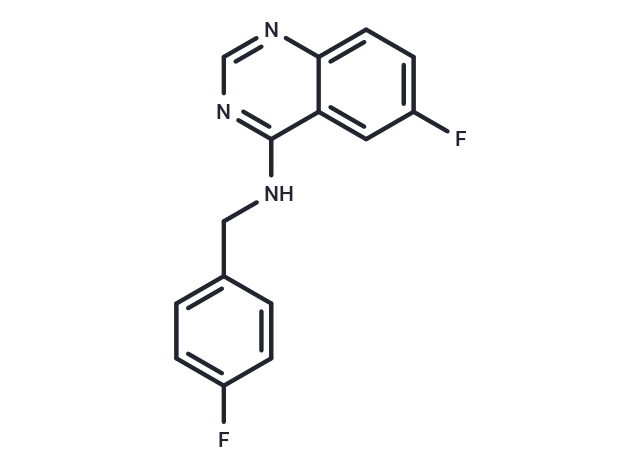Shopping Cart
- Remove All
 Your shopping cart is currently empty
Your shopping cart is currently empty

Spautin-1 is an autophagy inhibitor that suppresses the deubiquitination activity of ubiquitin-specific peptidase USP10 and USP13. Spautin-1 inhibits UPR and exhibits preferential cytotoxicity in glucose-starved cancer cells.

| Pack Size | Price | Availability | Quantity |
|---|---|---|---|
| 2 mg | $33 | In Stock | |
| 5 mg | $48 | In Stock | |
| 10 mg | $61 | In Stock | |
| 25 mg | $114 | In Stock | |
| 50 mg | $207 | In Stock | |
| 100 mg | $369 | In Stock | |
| 1 mL x 10 mM (in DMSO) | $53 | In Stock |
| Description | Spautin-1 is an autophagy inhibitor that suppresses the deubiquitination activity of ubiquitin-specific peptidase USP10 and USP13. Spautin-1 inhibits UPR and exhibits preferential cytotoxicity in glucose-starved cancer cells. |
| Targets&IC50 | K562:1.03 μM |
| In vitro | In Bcap-37 cells, Spautin-1 dramatically enhanced cell death in glucose-free media and induces apoptotic morphology. In Bax-Bak DKO cells, spautin-1 inhibits etoposide induced autophagic cell death. Spautin-1 promots the degradation of Vps34 complexes by regulating the deubiquitination activity of USP10 and USP13, and reduces the levels of PtdIns3P. [1] In PDGF-treated cells, spautin-1 stabilizes α-smooth muscle cell actin and calponin, prevents actin filament disorganization, diminishes production of extracellular matrix, and abrogates VSMC hyperproliferation and migration. [2] In CML cells, spautin-1 markedly inhibits IM-induced autophagy by downregulating Beclin-1, and enhances IM-induced apoptosis by inactivating PI3K/AKT and activating downstream GSK3β. [3] Spautin-1 also specifically reduces infectious dengue virus titers in BHK-21 cells. [4] |
| In vivo | Spautin-1 effectively mitigates the pathogenesis of acute pancreatitis induced by cerulein or L-arginine. Pretreatment with Spautin-1 significantly reduces elevated serum amylase and lipase levels, markers of trypsin activity, and inhibits the increase of serum TNFα caused by cerulein. Additionally, Spautin-1 treatment alleviates inflammation-induced damage such as edema, degeneration, coagulative necrosis, and the infiltration of inflammatory cells[5]. |
| Kinase Assay | Kinase inhibitory assays in Vitro: The inhibitory ability against each kinase except for MEK1 and Raf-1 is evaluated by examining their ability to phosphorylate various substrate peptides in the presence of CH5424802 using time-resolved fluorescence resonance energy transfer (TR-FRET) assay or fluorescence polarization (FP) assay. The inhibitory activity against MEK1 is evaluated by quantitative analysis of the phosphorylation of a substrate peptide by a recombinant ERK2 protein in the presence of CH5424802. The inhibitory activity against Raf-1 is evaluated by examining the ability of the kinases to phosphorylate MEK1 in the presence of CH5424802. |
| Cell Research | Spautin-1 is dissolved in DMSO. Cell proliferation is evaluated using CCK-8 kit. K562 cells (1x105/mL) are seeded into 96-well plates in triplicate and then treated with 125 to 4,000 nM IM alone or in combi?nation with spautin-1 (10 μM). After 48 h of incubation, 10 μL of CCK-8 reagent is added to each well. Four hours later, the absorbance is read at 450 nm using a microplate reader[1]. |
| Alias | Spautin 1 |
| Molecular Weight | 271.26 |
| Formula | C15H11F2N3 |
| Cas No. | 1262888-28-7 |
| Smiles | Fc1ccc(CNc2ncnc3ccc(F)cc23)cc1 |
| Relative Density. | 1.366 g/cm3 (Predicted) |
| Storage | Powder: -20°C for 3 years | In solvent: -80°C for 1 year | Shipping with blue ice. | |||||||||||||||||||||||||||||||||||
| Solubility Information | DMSO: 45 mg/mL (165.89 mM), Sonication is recommended. | |||||||||||||||||||||||||||||||||||
Solution Preparation Table | ||||||||||||||||||||||||||||||||||||
DMSO
| ||||||||||||||||||||||||||||||||||||

Copyright © 2015-2025 TargetMol Chemicals Inc. All Rights Reserved.